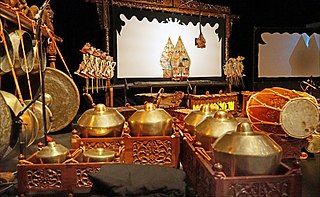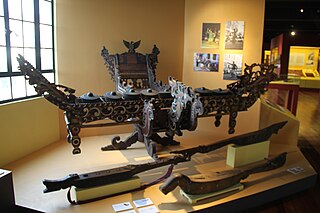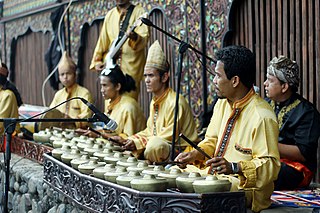
A gong is an East and Southeast Asian musical percussion instrument that takes the form of a flat, circular metal disc which is hit with a mallet.

Gamelan is the traditional ensemble music of the Javanese, Sundanese, and Balinese peoples of Indonesia, made up predominantly of percussive instruments. The most common instruments used are metallophones played by mallets and a set of hand-played drums called kendhang which register the beat. The kemanak and gangsa are commonly used gamelan instruments in Java. Other instruments include xylophones, bamboo flutes, a bowed instrument called a rebab, and even vocalists named sindhen.

The music of Indonesia demonstrates its cultural diversity, the local musical creativity, as well as subsequent foreign musical influences that shaped contemporary music scenes of Indonesia. Nearly thousands of Indonesian islands having its own cultural and artistic history and character. This results in hundreds of different forms of music, which often accompanies by dance and theatre.

Gamelan degung is a Sundanese musical ensemble that uses a subset of modified gamelan instruments with a particular mode of pelog scale. The instruments are manufactured under local conditions in towns in West Java such as Bogor. Degung music is often played at public gatherings in West Java, such as at local elections, as well as many other events. There is international interest in degung as well among communities in other countries interested in Indonesia and gamelan music.

Kulintang is a modern term for an ancient instrumental form of music composed on a row of small, horizontally laid gongs that function melodically, accompanied by larger, suspended gongs and drums. As part of the larger gong-chime culture of Southeast Asia, kulintang music ensembles have been playing for many centuries in regions of the Eastern Indonesia, Southern Philippines, Eastern Malaysia, Brunei and Timor, Kulintang evolved from a simple native signaling tradition, and developed into its present form with the incorporation of knobbed gongs from Sundanese people in Java Island, Indonesia. Its importance stems from its association with the indigenous cultures that inhabited these islands prior to the influences of Hinduism, Buddhism, Islam, Christianity or the West, making Kulintang the most developed tradition of Southeast Asian archaic gong-chime ensembles.
Pelog is one of the two essential scales of gamelan music native to Bali and Java, in Indonesia. In Javanese the term is said to be a variant of the word pelag meaning "fine" or "beautiful". The other, older, scale commonly used is called slendro. Pelog has seven notes, but many gamelan ensembles only have keys for five of the pitches. Even in ensembles that have all seven notes, many pieces only use a subset of five notes.

Gamelan gong kebyar is a style or genre of Balinese gamelan music of Indonesia. Kebyar means "to flare up or burst open", and refers to the explosive changes in tempo and dynamics characteristic of the style. It is the most popular form of gamelan in Bali, and its best known musical export.

The angklung is a musical instrument from West Java, Indonesia made of a varying number of bamboo tubes attached to a bamboo frame. The tubes are carved to have a resonant pitch when struck and are tuned to octaves, similar to Western handbells. The base of the frame is held in one hand, while the other hand shakes the instrument, causing a repeating note to sound. Each performer in an angklung ensemble is typically responsible for just one pitch, sounding their individual angklung at the appropriate times to produce complete melodies.

Kotekan is a style of playing fast interlocking parts in most varieties of Balinese Gamelan music, including Gamelan gong kebyar, Gamelan angklung, Gamelan jegog and others.
The ugal is an instrument in the Indonesian gamelan orchestra. It is a bronze metallophone played one handed with a small hammer, often in a dance-like manner. There are usually ten keys, giving a maximum range spanning about two octaves. Like the gangsa and gendér, they are suspended over tuned bamboo resonators.

A kempul is a type of hanging gong used in Indonesian gamelan. The kempul is a set of pitched, hanging, knobbed gongs, often made of bronze, wood, and cords. Ranging from 19 cm to 25,4 cm in diameter, the kempul gong has a flat surface with a protruding knob at the center and is played by hitting the knob with the "soft end of a mallet." "The wooden mallet used has a ball shape head with heavy padding on a short wooden handle. The number of kempul gongs present in a gamelan ensemble varies but, "although there can be two to ten kempul on one separate rack, it is common to have five kempul hanging on the same rack as the Gong ageng and gong siyem".

Gamelan semar pegulingan is an old variety of the Balinese gamelan. Dating back from around the 17th century, the style is sweeter and more reserved than the more popular and progressive Gamelan Gong Kebyar. Semar pegulingan is derived from the ancient flute ensemble gamelan gambuh which utilizes a 7 tone scale. Semar pegulingan also uses the 7 tone scale which enables several pathet to be played. Semar is the name of the Hindu God of love and pegulingan means roughly 'laying down'. It was originally played near the sleeping chambers of the palace to lull the king and his concubines to sleep. The ensemble includes suling, various small percussion instruments similar to sleigh bells and finger cymbals, and trompong - a row of small kettle gongs that play the melody. A similar type of ensemble, Gamelan Pelegongan, substitutes a pair of gendérs for the trompong as the melody carrier and plays the music for a set of dances known as legong.

The gong ageng is an Indonesian musical instrument used in the Javanese gamelan. It is the largest of the bronze gongs in the Javanese and Balinese gamelan orchestra and the only large gong that is called gong in Javanese. Unlike the more famous Chinese or Turkish tam-tams, Indonesian gongs have fixed, focused pitch, and are dissimilar to the familiar crash cymbal sound. It is circular, with a conical, tapering base of diameter smaller than gong face, with a protruding polished boss where it is struck by a padded mallet. Gongs with diameter as large as 135 centimeters have been created in the past, but gongs larger than about 80 centimeters are more common especially to suit the budget of educational institutions.

The bonang is an Indonesian musical instrument used in the Javanese gamelan. It is a collection of small gongs placed horizontally onto strings in a wooden frame (rancak), either one or two rows wide. All of the kettles have a central boss, but around it the lower-pitched ones have a flattened head, while the higher ones have an arched one. Each is tuned to a specific pitch in the appropriate scale; thus there are different bonang for pelog and slendro. They are typically hit with padded sticks (tabuh). This is similar to the other cradled gongs in the gamelan, the kethuk, kempyang, and kenong. Bonang may be made of forged bronze, welded and cold-hammered iron, or a combination of metals. In addition to the gong-shaped form of kettles, economical bonang made of hammered iron or brass plates with raised bosses are often found in village gamelan, in Suriname-style gamelan, and in some American gamelan. In central Javanese gamelan there are three types of bonang used:

Talempong is a traditional music of the Minangkabau people of West Sumatra, Indonesia. The talempong produce a static texture consisting of interlocking rhythms.

Colotomy is an Indonesian description of the rhythmic and metric patterns of gamelan music. It refers to the use of specific instruments to mark off nested time intervals, or the process of dividing rhythmic time into such nested cycles. In the gamelan, this is usually done by gongs of various size: the kempyang, ketuk, kempul, kenong, gong suwukan, and gong ageng. The fast-playing instruments, kempyang and ketuk, keep a regular beat. The larger gongs group together these hits into larger groupings, playing once per each grouping. The largest gong, the gong ageng, represents the largest time cycle and generally indicates that that section will be repeated, or the piece will move on to a new section.
Notation plays a relatively minor role in the oral traditions of Indonesian gamelan but, in Java and Bali, several systems of gamelan notation were devised beginning at the end of the 19th century, initially for archival purposes.

Kroncong is the name of a ukulele-like instrument and an Indonesian musical style that typically makes use of the kroncong. A kroncong orchestra or ensemble traditionally consists of a flute, a violin, at least one, but usually a pair of kroncongs, a cello in pizzicato style, string bass in pizzicato style, and a vocalist. Kroncong originated as an adaptation of a Portuguese musical tradition, brought by sailors to Indonesian port cities in the 16th century. By the late 19th century, kroncong reached popular music status throughout the Indonesian archipelago.

Gamelan gender wayang is a style of gamelan music played in Bali, Indonesia. It is required for wayang and most sacred Balinese Hindu rituals. The smallest of gamelan ensembles, it requires only two players and is complete at four, the additional instruments doubling an octave above. Like other gamelan genres, it incorporates delicate interlocking melodies and active contrapuntal movement, yet poses unique challenges in technique and composition.

The tube zither is a stringed musical instrument in which a tube functions both as an instrument's neck and its soundbox. As the neck, it holds strings taught and allows them to vibrate. As a soundbox or it modifies the sound and transfers it to the open air. The instruments are among the oldest of chordophones, being "a very early stage" in the development of chordophones, and predate some of the oldest chordophones, such as the Chinese Se, zithers built on a tube split in half. Most tube zithers are made of bamboo, played today in Madagascar, India, Southeast Asia and Taiwan. Tube zithers made from other materials have been found in Europe and the United States, made from materials such as cornstalks and cactus.













